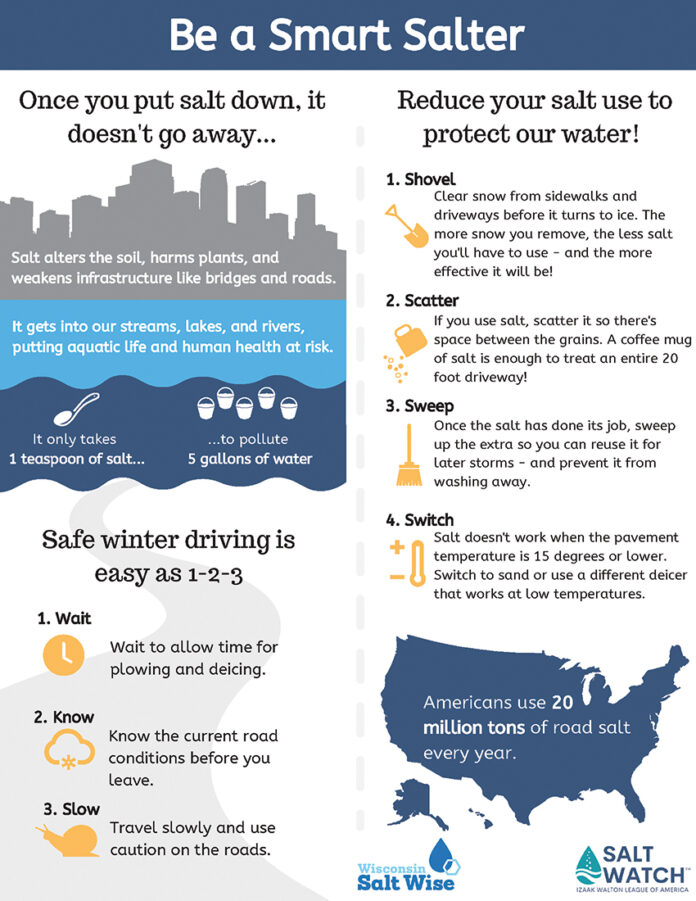Shorter days, cloudy skies, colorful leaves and frosty nights are telltale signs that autumn is actually and finally here… for now, that is. Despite the fluctuating temperatures and wacky weather patterns, our region’s beloved (though often cursed!) change of seasons is something that we can always count on. It won’t be long until these falling leaves become falling snowflakes, and we’ll be hanging up the rakes and reaching for the shovels.
No matter the season, what we do on the land affects the quality of our water and no exceptions are made for old man winter. Because the ground is often frozen during this time it acts as an impervious surface, preventing snowmelt and runoff from naturally soaking into the ground and being filtered. In addition, our region’s notorious snowfalls tend to bring with them a heavy dose of salt.
Sodium chloride (NaCl) in the form of crushed rock salt, that is. Since the 1940’s, this road salt has become the most effective and affordable way of keeping our roads clear of snow and ice. Nationwide every winter an average of 20 million tons of road salt are applied to our miles and miles of roads, parking lots, sidewalks and driveways. While usage fluctuates with the severity of the winter, the amount of impervious pavement due to urbanization continues to increase. Though critical to our safety, the cumulative effect of salting roads to keep our society moving has large environmental and economic costs.
Application matters
Throughout 2023, the Geauga Soil and Water Conservation District and other northeast Ohio districts and agencies have been promoting ways to reduce the amount of salt applied through sensible salting strategies. Just like too much salt in your diet can be bad for your health, too much salt on our roads is harmful to our water and soil.
After application, road salt is carried by melting snow and rain into local lakes, streams and groundwater. According to the Ohio Environmental Protection Agency, there is a trend of increasing chloride concentrations in our rivers and lakes across the northern tier of the U.S. and Canada and the long-term environmental impacts of salting our roads is greatly contributing to the alarming salinization of our freshwater.
Salt impacts
Ohio, in fact, now ranks third nationwide for tons of salt applied. Studies confirm that this increased concentration of chloride disrupts freshwater food webs and ecosystems by decreasing zooplankton populations, increasing algae concentrations and negatively impacting fish and insect size and reproduction rates. High concentrations of sodium are fatally toxic to aquatic critters, destroy soil stability, decrease soil’s ability to filter water and increase soil erosion.
When winter precipitation comes to town, roadway snow and ice removal for public safety will always be our first and foremost priority. After sifting through the many deicing methods and materials, we see that road salt remains king: rock solid for its affordability, abundance and ease of mining, storing, distributing and spreading.
As watershed residents, we know that our daily habits and backyard behaviors inadvertently yet collectively contribute to stormwater pollution. Though we may not be able to control how much salt is put on the roads, we can control our own salting behaviors on our driveways and sidewalks. Simple changes to the amount and ways that we salt can greatly improve the health of our watershed without jeopardizing our safety. The following savvy and sensible salting tips are easy to remember and will help save your money and time.
This winter remember to use the right S.A.L.T.
STUFF — Salt (sodium chloride) only works above 15 degrees F. For colder temperatures use a small amount of sand for added traction, or switch to an ice-melting product designed to work at colder temperatures. Products containing calcium chloride can melt ice in temperatures as low as -25 degrees F. Remember that chloride in deicers is what burns your pets’ paws and deteriorates concrete.
AMOUNT — Use a gentle hand and spread only enough salt to do the job. One 12-ounce coffee mug full of salt is enough to effectively deice 250 square feet, which is equivalent to about 10 sidewalk squares. Remember that more salt does not mean more melting. Just like fertilizer on your lawn, too much only damages soil and pollutes water. It only takes one teaspoon of road salt to permanently pollute five gallons of water. Also, be sure to sweep up extra salt and sand once the ice melts to ensure it doesn’t wash into a ditch, storm drain, or nearby stream. If it is visible on dry pavement, its job is done.
LOCATION — Spread salt only on the surfaces of your driveway and sidewalk that need to be deiced and never on the lawn, at the base of trees, or near a stream or storm drain. Consider locations where paths through the snow can be created rather than removing all of the snow.
TIME — Salt works best when it is applied right before the snow falls or right after snow is removed from your driveway or sidewalk, and never when rain is in the forecast. Also shoveling and removing snow and ice during a snowstorm reduces the amount of salt required for deicing and increases the efficiency of your efforts.
The old adage says “It takes a village” and when it comes to salting our neighborhoods, we can significantly reduce the negative impacts of sodium chloride within our village with increased awareness and proper application. Armed with knowledge and shovels, it’s time we get smart about salt to secure the necessary safety of both our roadways and waterways.













